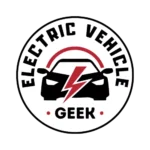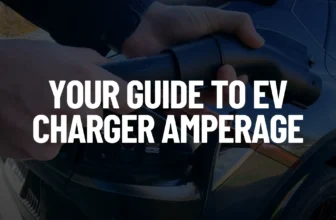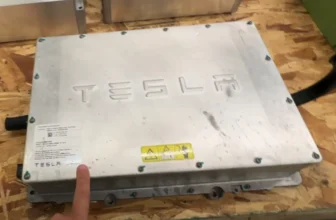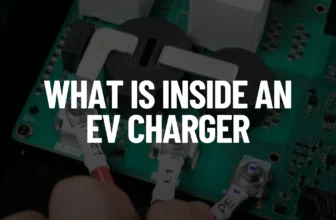Electric vehicle charging overcurrent protection is the lifeline that keeps an electric vehicle branch circuit running safely, it manages the flow of current to the EV charger and prevents them from overloading, which can happen if the EV charger is drawing more power which can lead to overheating, fire, and damaged cables or connectors.
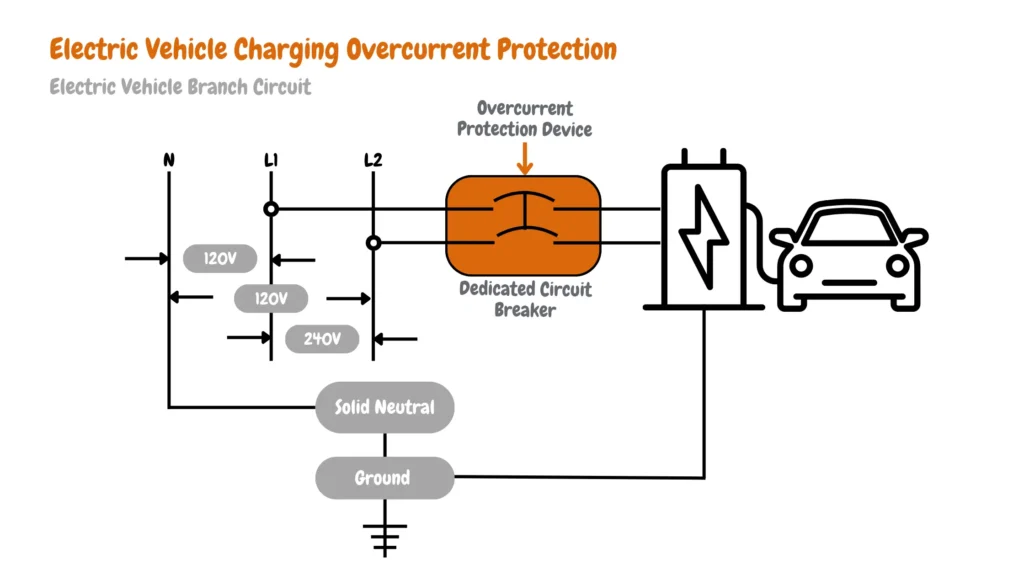
Electric vehicle charging overcurrent protection is typically provided by either an EV charger circuit breaker, fuse, or relays installed between the electrical panel main breaker, and the EV charger, the work of the EV charger circuit breaker is to automatically disconnect the flow of current to the EV charger if the current exceeds the specified thresholds.
Table of Contents
How Overcurrent Protection Works in EV Charging
There are two ways an electric vehicle charging infrastructure protects the whole EV charging system from overcurrent, it includes EV charger overcurrent protection (Internal), and electrical vehicle branch circuit overcurrent protection (External).
Your EV charging system benefits from several approaches to overcurrent detection and protection.
Outside the EV Charger: Overcurrent Protection
Outside the EV charger, a dedicated circuit breaker in your home’s electrical panel acts as the first line of defense. It cuts power during overloads or short circuits in the charging system, protecting your entire electrical setup. Features for overcurrent protection in your existing EV charger circuit include circuit breakers, fuses, and Ground Fault Circuit Interrupters (GFCIs) like GFCI circuit breakers and outlets.
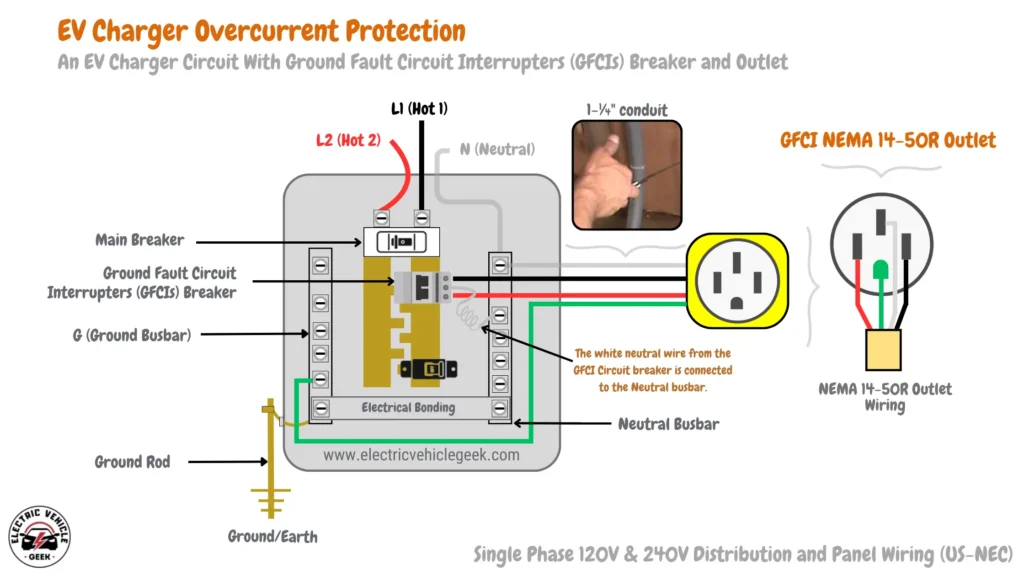
Inside the Charger: Overcurrent Protection
Inside the EV charger itself, a fuse safeguards its delicate internal components. Unlike a resettable breaker, a fuse is designed to permanently melt during extreme current surges, isolating the charger and preventing damage. While a blown fuse requires replacement by a qualified electrician, this sacrificial protection ensures your charger’s safety.
Overcurrent Detection in the Cable Control Box of an EV Charger
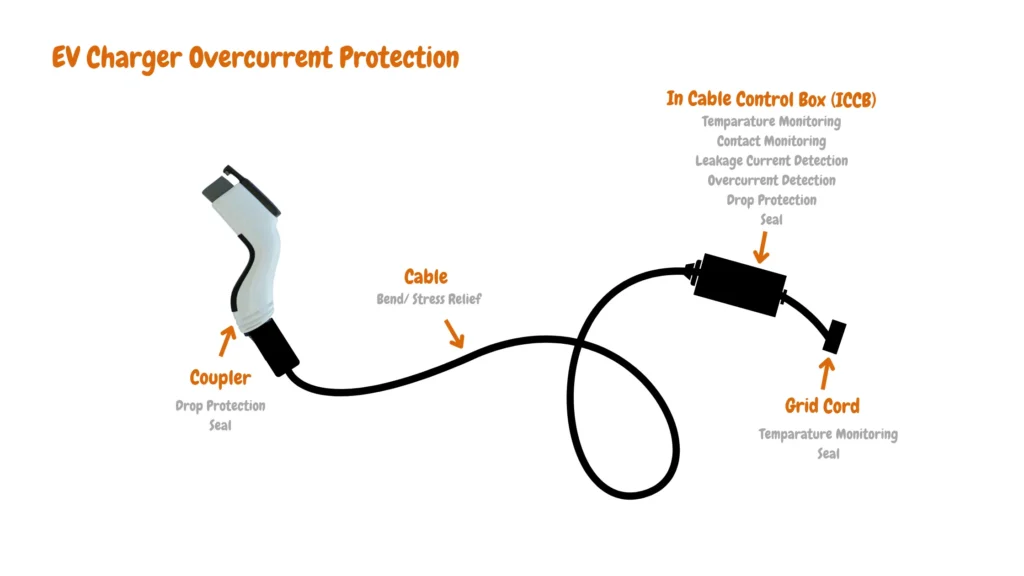
The cable control box is usually located within the EV charger itself, or close to the charging connector. It houses various components, including the overcurrent detection system. There are two primary methods for overcurrent detection in the cable control box:
- Current Transformers (CTs): These are non-intrusive sensors that wrap around the cable carrying the charging current. CTs sense changes in the magnetic field generated by the current and convert them into a proportional signal. This signal is then monitored by the control circuitry within the cable control box.
- Shunts: These are low-resistance resistors placed in series with the charging current path. Any increase in current flow will cause a measurable voltage drop across the shunt. This voltage drop is monitored by the control circuitry to detect overcurrent situations.
When the overcurrent detection system identifies a current exceeding safe limits, it sends a signal to the control unit within the EV charger. The control unit then takes immediate action, typically by:
- Stopping the charging process: This is the most common response. The control unit will cut off power delivery to the electric vehicle’s battery.
- Alerting the user: The charger might display an error message or indicator light to inform the user about the overcurrent event.
Types of Overcurrents Protection in EV Charging
Let’s delve into the three main types of overcurrents and how they impact EV charging:
EV Charging Overload Current
Imagine a single-lane highway overwhelmed by rush hour traffic. An overload current scenario occurs when the EV charger attempts to draw more current than the circuit is designed to handle. This can happen due to:
- Faulty charger: A malfunctioning charger might demand excessive current.
- Combined load: Charging your EV while running other high-power appliances on the same circuit can overload it.
Expert Tip: To prevent overload, consult an electrician to assess your home’s electrical capacity and ensure your EV charging circuit is properly sized. Additionally, avoid running power-hungry appliances simultaneously while charging.
EV Charging Short-Circuit Current
Think of a short-circuit current as a sudden road closure on a busy highway. It occurs when a live wire makes unintended contact with another wire or a grounded surface, creating a low-resistance path for electricity. This rapid surge can be dangerous and requires immediate interruption.
EV Charging Risks: A short circuit within the EV charger itself or the charging cable can lead to overheating and fire hazards.
Expert Tip: Regularly inspect your EV charging cable for signs of damage or wear. Additionally, ensure proper connection at both the charger and vehicle to minimize the risk of short circuits.
EV Charging Ground-Fault Current
Imagine a water leak diverting water flow away from its intended path. A ground-fault current arises when electricity escapes its intended circuit and travels to the ground (often through damaged wires or moisture intrusion).
EV Charging Risks: Ground faults can damage the EV charger’s internal components and, in extreme cases, pose shock hazards.
Expert Tip: Implement Ground Fault Circuit Interrupters (GFCIs) in your EV charging circuit. GFCIs can detect leakage currents and quickly shut off power, preventing potential hazards.
By understanding these overcurrent events and taking preventive measures, you can ensure safe and reliable EV charging at home.
Benefits of Overcurrent Detection in EV Charging
- Prevents overheating: Excessive current can cause overheating in the charging cable and charger components. Overcurrent detection helps prevent this, safeguarding the equipment.
- Protects the electrical system: An overcurrent situation could overload the circuit feeding the charger, potentially tripping the circuit breaker or even causing wiring damage. Overcurrent detection helps prevent this by stopping the charging process before such an overload occurs.
- Fire prevention: In extreme cases, overcurrent events can lead to fire hazards. Overcurrent detection plays a vital role in mitigating this risk.
Overall, overcurrent detection in the cable control box is a critical safety feature for EV chargers. It ensures safe and reliable charging by preventing damage to the charger, cable, and electrical system.
FAQs
Do electric cars have overcharge protection?
Yes, electric cars (EVs) are equipped with built-in overcharge protection mechanisms. This includes a sophisticated Battery Management System (BMS) that monitors the battery’s health and charge status continuously. As the battery approaches full capacity, the BMS adjusts the charging rate to prevent overcharging. Additionally, many EVs offer the option to set a maximum charging limit below 100%, which can extend battery longevity by reducing stress on the cells. Moreover, EV chargers communicate directly with the BMS, automatically halting charging when the battery reaches full capacity.
Do you need surge protection for EV chargers?
Yes, while your EV charger has built-in protections, surge protection offers an extra layer of security for your valuable equipment and electrical system. It’s always best to consult with a qualified electrician to determine the specific regulations in your area and ensure proper installation of surge protection for your EV charger.

James Ndungu is a certified EV charger installer with over five years of experience in EVSE selection, permitting, and installation. He holds advanced credentials, including certification from the Electric Vehicle Infrastructure Training Program (EVITP) and specialized training in EV charging equipment and installation, as well as diplomas in EV Technology and Engineering Fundamentals of EVs. Since 2021, James has tested dozens of EV chargers and accessories, sharing expert insights into the latest EV charging technologies.
